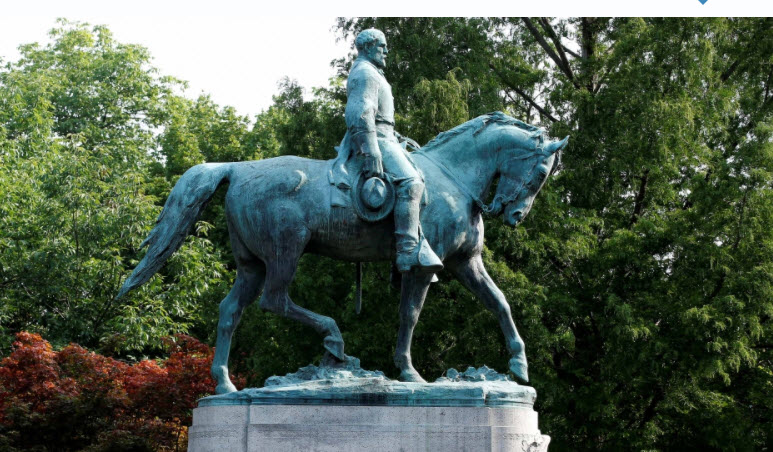One conflict that took centre stage over the last week had to do with statues commemorating the Confederacy, and their link to racism and white supremacy. (The image above is of Confederate General, Robert E. Lee, and is in Charlottesville, Virginia; credit: Joshua Roberts/Reuters)
From an early age, I was put on notice about racists and supremacy of one race over another. My dad was a German Jew. He was 21 years old when he left Germany in 1938. You can guess the reason why he had to leave.
Not surprisingly, I believe in social justice. I’m also a mediator. I appreciate responses to conflict that creatively seek to bridge differences while staying true to the bigger picture.
Two such responses, related to the Confederacy statues, caught my eye this week, both via my Twitter feed:
Confederacy statues in context of (future) truth and reconciliation
The first was a CBS video interview of Bryan Stevenson Bryan Stevenson, Founder and Executive Director of the Equal Justice Initiative (EJI). I admire Stevenson and his organization, and profiled them a couple of years ago on this blog. EJI is helping address the crazy inequalities in the US justice system; e.g., mass incarceration of blacks.
Stevenson is a realist and understands steps needed to get to the end goal; e.g., no more Confederate statues.
“White supremacy has done horrific, destructive things.” Public interest Lawyer Bryan Stevenson talks w/Anthony Mason. Our full interview pic.twitter.com/L1Ac3B2ZDf
— CBS Evening News (@CBSEveningNews) August 16, 2017
(video not displaying: watch it here, on Twitter)
Stevenson’s points include:
- Charlottesville is a manifestion of a failure to honestly confront a history of slavery, lynching, terrorizing blacks, segregation…
- What’s missing is truth and reconciliation; truth comes first (look to Canada?)
- One truth is there should be no moral equivalency to racism
- We can’t be ambivalent to the dangers posed by Nazism and fascism, and “i’m better than you because of my colour”
- Long-term goal is no confederacy monuments
- In the interim, need to erect and make visible a different iconography
- EJI is trying to erect markers that talk about the legacy of slavery; “in Berlin, Germany, you can’t go a 100 metres without seeing a marker or a stone that’s been placed next to the home of a Jewish family that was abducted during the Holocaust”
On the importance of monuments
The second item features commentary from Laurent Dubois, professor of history at Duke University in Durham, North Carolina; What do do with America’s Confederate statues and monuments.. Dubois says, “Monuments are the public embodiment of social values, and have to be reconsidered and transformed as society changes”.
Dubois’ points:
- Tear the statues down, but leave the empty pedestals, and develop historical panels explaining their history as monuments.
“Alongside them (empty pedestals), Americans could place panels with photographs recounting how and why they came down. In that way you’d actually get a sense of the dynamism of history, and the fact that monuments are about public declaration of values.”
- A monument always has to do with three different historical moments.
“ It’s (monuments is) a reference to a particular moment in the past. It’s also a representation of the moment when it was built … and then we in the present have to think about these monuments and what they mean today, and whether they fit with our values as a society.”
- Public spaces/art need to cultivate and expand a broader historical memory (i.e., black history)
“The history of slavery itself — the history of abolitionists, the history of how slavery was destroyed, the history of the enslaved people who fought against slavery — all those are things that could be much better known and much more present in our public spaces.”
“One solution is to think about that … both the removal of some monuments, but also what kinds of public art, what kinds of public recognition of history do we want to foreground?” he says. “There are lots and lots of Americans that have fought for justice and equality, who fought against slavery, who could be acknowledged and could be celebrated.”
Both of the above commentaries, Stevenson’s and Dubois’, offer rich understanding and solution options. They caught my mediator eye.
Have you come across any other creative ideas for dealing with Confederacy statues?
[Ben Ziegler provides conflict management services for small to medium-sized businesses, nonprofits and local governments. Contact Ben.]


Speak Your Mind